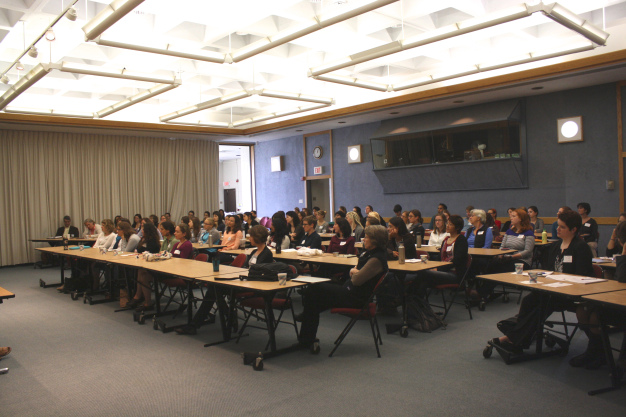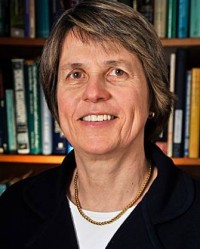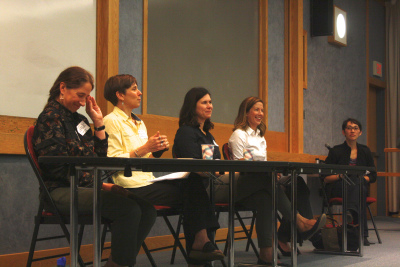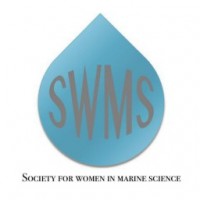Featured Stories | October 9, 2014
Women in Marine Science Seize the Day
By Genevieve Wanucha
The inaugural workshop of the Society for Women in Marine Science (SWMS) took place at Woods Hole Oceanographic Institution on September 26, 2014. A diverse mix of over ninety women in science filled the seats, ranging from new graduate students eager to build a community to post docs who are some of the only women on their floors at work, and from university deans who make hiring decisions to assistant professors at varying stages of career and family development.
It’s a well-known phenomenon: while many female graduate students work in the marine sciences, and STEM fields in general, less women go on to post doctoral positions, and even fewer to full professorships. “We think that by creating a group of women marine scientists who can support each other and their ideas, address the challenges they face, and engage in mentoring and networking, we might be able to address this problem of retention,” said Katya Frois-Moniz, a post doc in the Chisholm lab at MIT, who organized the workshop along with the other members of the SWMS steering committee: Alexis Yelton, a post doc in the Chisholm lab at MIT, Sophie Chu, a fourth year graduate student in the MIT/WHOI Joint Program, and Bethanie Rachele Edwards, a third year graduate student in the MIT/WHOI Joint Program.

In the key note speech, Sallie “Penny” Chisholm, MIT Professor of Biology, shared her experience as one of the original advocates for the status and treatment female science faculty at MIT. In 1994, there were 15 tenured women faculty in the six departments of the School of Science vs. 194 tenured male professors, and the percentage of female faculty in the MIT School of Science had not budged from 8% in 20 years. The female faculty started meeting to talk about their concerns and eventually took action. “I’ll never forget the day we marched into the Office of the Dean, Robert J. Birgeneau,” said Chisholm. “One woman actually put a skirt on for the first time. We had no idea how he would react. He was skeptical at first, but welcomed us. Because there were 16 of us, he knew he had a problem on his hands.” The Dean, along with MIT President Charles Vest, soon helped the female professors form the MIT Committee on Women Faculty in the MIT School of Science, which would collect data and analyze the position of female scientists at MIT.
A Sea Change
The resulting report in 1999 uncovered clear gender inequities in hiring, salary, pension, awards, promotions, inclusion on committees, and allocation of valuable resources such as laboratory space and research money at MIT. The data highlighted a pattern recurring over generations: while junior female faculty members tended not to sense any discrimination, once they were senior faculty in competition with their male colleagues, they felt marginalized and overlooked in the male-dominated departments. The report’s findings made headlines in every major newspaper when President Vest, a strong ally of the MIT women, publicly admitted that MIT discriminated against female faculty and pledged to make all necessary changes.

Chisholm said that working on this committee was one of the most positive experiences of her career because of the MIT administration’s swift and effective response. Salaries were adjusted, and policies on maternity leave and tenure clock extension for one year after childbirth eventually became standard across the university. Hiring practices changed. For example, the Dean of the School of Science would not approve the appointment of a male faculty candidate if un-interviewed women remained on the candidate list. Women gained seats on search committees and actively sought out outstanding female candidates at lectures. Suddenly, it had become an asset for the entirely male-run departments in the School of Science to be aware of the lack of female faculty and proactively take steps to address it. “It was a sea change,” said Chisholm. “There was finally this recognition that they couldn’t go another decade with one female on the faculty.”
According to a 2011 follow up report of gender equity at MIT, women now make up 21% of faculty in the MIT School of Science and hold positions at every rung of power in the MIT administration. Chisholm gives all credit to the 1994 “uprising,” as she calls it. “Some people think that increase in female faculty happened through evolution and natural selection. We all know that’s not how it happened,” she said. “It happened through effort.” She noted the indispensable leadership of extraordinary people such as Nancy Hopkins, Professor of Biology at MIT, “who was willing to explode,” and men such as President Vest who used his position of power to fix problems.
It’s Complicated
Today’s women in science still face challenges specific to their gender, and that’s why the workshop drew a crowd. Chisholm mentioned the problem of ‘imposter syndrome,’ when a young woman feels like she doesn’t belong or isn’t good enough, based on a perception that she made it into a lab because of affirmative action. “it’s debilitating,” she said from experience. “The important thing is to not let it get to you.” Then there are the undermining stereotypes in academia that women have to work twice as hard as men to achieve the same thing and that women are patient and understanding, when they actually might just be as busy and ambitious as a man. Chisholm also highlighted a recent study showing that elite males in the life sciences train fewer females in their labs. Most disheartening, she noted, is that both genders make unconscious judgements about the inferior talent of women compared to men in research studies, but such thinking can be thwarted through awareness and the ability to catch oneself making a biased judgement. [PDF of Dr. Sallie Chisholm’s talk – the MIT Gender Equity Study, including links to gender research referenced]
Having children is the single factor that goes the farthest in explaining the dearth of women in tenured positions in science. Chisholm presented data showing that of the women and men post docs who decide to abandon the tenure track, only the women’s decisions are correlated with number of children. “I always have said that if women designed the structure of academia, tenure would not coincide with a major decrease in fertility,” said Chisholm, who does not have children. “It’s just so exciting to me now to see women having children during these careers because I could not even imagine it when I was going through it. But it still doesn’t mean it’s easy, and there are sacrifices,” she said. “Until women don’t have to make choices about family relative to men, we are not going to have equity.”
Chisholm offered no simple answers to these complex issues. Indeed, the policies employed at many universities, such as maternity and family leave, extension of the tenure clock after child birth, and financial grants to ease the transition back to academia, are not always effective. “If you are in a fast moving field like we all are, if you step off for a number of years, and then get a little grant for re-entry, you know you aren’t going to catch up,” she said to a murmur of agreement from the audience. “I think we need to acknowledge that some of these solutions are not solutions.”

The workshop’s panel on challenges and solutions for women marine scientists proved again and again that becoming a successful faculty member and having a family is possible, if you really want it. The panelists included Heidi M. Sosik (SM ’88 MIT), Senior Scientist, WHOI, Wally Fulweiler, Associate Professor, Earth and Environment/Biology, Boston University, Helen White (PhD ’06 MIT/WHOI), Assistant Professor, Chemistry, Haverford College, and Juanita Urban-Rich, Associate Professor, School for the Environment, UMASS Boston. Some had multiple young children; others couldn’t see how they do it. The women related intensely personal experiences, such as being told that women are not fit for ocean research cruises but going to sea anyway; the awkwardness of pumping breast milk on a research cruise and storing the bottles in the crew’s ice cream freezer; and the painful, yet ultimately positive, experience of leaving a baby at home with the father for months to complete a research mission. They discussed the ingredients of success as a female scientist, whether one has children or not, including having a partner willing to take on more of the household duties at times, cultivating a strong communication ethic in the lab, setting priorities, learning professional negotiation skills, and being able to say no.
Take Home Messages
During the networking coffee hour, the attendees said they valued the chance to build a community and the opportunity for a dedicated discussion about real issues that affect everyone. The take home messages of Chisholm’s eye-opening talk resonated: Speak out if you sense a lack of diversity, but don’t organize alone. Build a community. You are good enough. Just by persisting, you are making a difference. Recruit men and help them understand the problem.
One of the three men who attended, David C. Smith, Professor and Associate Dean in the Graduate School of Oceanography at the University of Rhode Island, said “I drove up here today because I thought it was important to hear the concerns,” fulfilling Chisholm’s call for men in science to develop awareness about gender equity issues. “I know I’ve sat in countless meetings with only one or two women present and didn’t think anything of it. The experience was flipped on me today. I understand now how it feels to be one of the only of my gender in the room. It’s not a comfortable feeling.”
The workshop ultimately mapped the true dimensions of the challenges and solutions for women in marine science and clarified why it is important to care about the number of women who reach higher levels in science. The reason was captured best by Chisholm, in a paraphrase of MIT President Charles Vest’s remarks at Nancy Hopkins’ retirement party in 2012: “The point is not fairness. The point is that unless we increase diversity in our ranks, we are not realizing our potential as human beings to make the world a better place and enhance our scientific and technological capabilities.”






